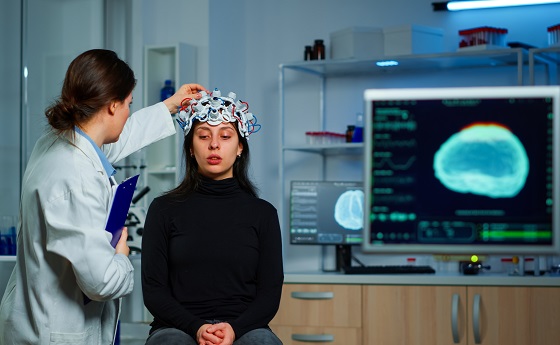- Emergency Ambulance Services
- 8606811111
- 0471-4077777, 0471-7177888
- gro@sutpattom.com
Brain Aneurysm & pin-hole treatment
Dr. Praveen A. Senior Consultant – Neuro and Vascular Interventional Radiology ,SUT Hospital, Pattom
What is brain aneurysm?
Aneurysms are disease affecting blood vessels in which weak areas of blood vessels bulge outward like a balloon. When it expands beyond its capacity, they tend to rupture resulting in bleeding into brain and or surrounding CSF, which can be serious with life-threatening and catastrophic consequences.
What causes brain aneurysm?
The weakening of the wall of the blood vessel can be due to congenital causes, but more commonly this occurs when there is increased stress on weak areas of blood vessels, like at point of bifurcation. Blood vessel wall becomes weak due to certain factors like diabetes, hypertension, smoking, and substance abuse. These areas further bulge to form aneurysm and rupture when blood pressure shoots up suddenly.
How common is brain aneurysm?
Brain aneurysms are seen in about 2% of population. The incidence is higher in individuals with lifestyle diseases like hypertension and diabetes. Sometimes, aneurysms may be detected prior to rupture during scanning of brain for other reasons.
What are the symptoms of brain aneurysm?
Unruptured brain aneurysm are usually silent. There will not be any symptoms. Rarely it can present with headache or with vision abnormalities, due to compression on the neighbouring structures.
When an aneurysm ruptures, it presents as sudden severe headache, vomiting, visual disturbance, seizures, limb weakness or loss of consciousness, which can deteriorate rapidly and can be life-threatening, if not immediately managed with interventional procedures.
What happen when aneurysm rupture?
When it ruptures, blood rushes out from blood vessels into brain or into the fluid
surrounding brain. If the rupture is small, bleeding can temporarily stop for some time, so that we get time to treat and prevent further life-threatening bleed. If large rupture, this will rapidly increase in size and exert pressure and damage brain resulting in coma or death.
About 50% patients with ruptured aneurysm die within 3months, out of which, close to quarter within 24hrs. Those surviving also can have significant brain damage. Prompt treatment can reduce the chance of mortality and brain damage.
What are the reasons for an aneurysm to rupture?
Aneurysms rupture when there is increased pressure on its wall. This is usually due to increased blood pressure. Thus, all situations which can cause increased blood pressure like, stressful conditions, doing heavy work or not taking BP medications regularly, can lead to rupture of aneurysm. Also, certain factors related to aneurysm, like size, shape, certain locations make them more prone to rupture.
How is brain aneurysms diagnosed?
Aneurysms are diagnosed using scanning techniques like CT Angiography, MR Angiography. If these tests are negative, and if doctor feels high suspicion of having aneurysm, advanced testing like digital subtraction angiography test needs to be done.
When to treat?
Most aneurysms should be treated as early as possible once diagnosed, especially ruptured aneurysm. A second rupture will cause irreversible damages and lead to death.
How are aneurysms treated?
Aneurysms are treated either by open surgery or by pinhole surgery through blood vessels. In both techniques, aneurysms are treated by blocking blood flowing to aneurysm. Open surgical treatment is done by a neurosurgeon and pinhole treatment through blood vessel is done by neurointerventional radiologist, specially trained in these procedures. Selection of optimal technique for treating depends on the general condition of patient as well as the aneurysm nature.
In open surgery, this is done by making small opening in skull and placing a metal clip at the base of aneurysm (between blood vessel and aneurysm), so that blood flowing into aneurysm is blocked.
Most of the aneurysms can be treated using minimally invasive pinhole surgery, which is done through blood vessels, like doing an angiogram. This is done by passing small tubes and devices through blood vessels under live visualisation using scanning techniques like x-rays. In this technique also, the blood flowing to aneurysm sac is blocked using various devices like coils and stents etc.
Most common technique is coiling. This is done by packing the aneurysm sac with coils, using small catheters, so that blood cannot enter sac. In some cases, additional stent or balloon will be kept in the blood vessel to prevent coil prolapsing into the blood vessel. In some cases, instead of coils, mesh like devices called WEB device is placed within aneurysm. In some aneurysms, coiling is not feasible and require special techniques and devices like flow diverter, which are placed within the blood vessels to divert blood flow away from the aneurysm. Rarely, the only option will be to occlude the artery harbouring aneurysm to prevent life threatening bleed.
How long is the recovery time and hospital stay for these treatments?
In case of aneurysms which are not ruptured, hospital stay will be less. In case of pinhole interventional treatment, patients can get discharged in 2days and resume normal activities. Open surgery might require longer time for resuming normal activities.
For ruptured aneurysms, hospital stay will be more prolonged. This is for recovering from the effects and damage to the brain structures because of complications due to rupture of aneurysm and bleeding inside skull.









